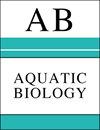蛤壳周鞣制过程中漆酶基因的鉴定
IF 0.8
4区 生物学
Q3 MARINE & FRESHWATER BIOLOGY
引用次数: 4
摘要
鞣制是一个复杂的细胞外过程,是一种稳定蛋白质细胞外结构的机制。酚氧化酶在鞣制过程中起着重要的交联作用,漆酶(EC 1.10.3.2)是酚氧化酶类的一员。在本研究中,我们从蛤蚌中鉴定出一个漆酶基因(MpLac),并发现MpLac可能参与了蛤壳膜鞣制过程。利用全贴装原位杂交技术,我们发现mplacmrna在蛤蚌幼体中主要在地幔边缘表达。我们的实时荧光定量PCR结果显示,在成年蛤中,地幔也是mplace高表达的组织;此外,结合荧光原位杂交、H&E染色和透射电镜结果,我们发现,参与骨膜形成的地幔边缘外褶皱内上皮正是mplacmrna表达的区域。此外,通过RNA干扰(RNAi)抑制mplaca的表达,使新壳膜脱色。我们所有的结果都表明MpLac参与了斑点分枝杆菌的壳周鞣制。本文章由计算机程序翻译,如有差异,请以英文原文为准。
Identification of a laccase gene involved in shell periostracal tanning of the clam Meretrix petechialis
Tanning is a complex extracellular process that is a mechanism for stabilizing proteinaceous extracellular structures. Phenoloxidases play important roles in cross-linking during tanning, and laccase (EC 1.10.3.2) is a member of the phenoloxidase enzyme class. In this study, we identified a laccase gene (MpLac) from the clam Meretrix petechialis and found that MpLac might be involved in shell periostracal tanning of clams. Using whole-mount in situ hybridization, we found that MpLac mRNA in the larval clam was mainly expressed in the mantle edge. In the adult clam, our quantitative real-time PCR results showed that the mantle was also a tissue with a high MpLac expression level; in addition, by combining the results of fluorescence in situ hybridization, H&E staining and transmission electron microscopy, we found that the inner epithelium of the outer fold of the mantle edge, which is involved in periostracum formation, was the exact region in which MpLac mRNA was expressed. Furthermore, knocking down the expression of MpLac by RNA interference (RNAi) bleached the new shell periostracum. All of our results suggest the involvement of MpLac in shell periostracal tanning of M. petechialis.
求助全文
通过发布文献求助,成功后即可免费获取论文全文。
去求助
来源期刊

Aquatic Biology
生物-海洋与淡水生物学
CiteScore
2.70
自引率
0.00%
发文量
7
审稿时长
3 months
期刊介绍:
AB publishes rigorously refereed and carefully selected Feature Articles, Research Articles, Reviews and Notes, as well as Comments/Reply Comments (for details see MEPS 228:1), Theme Sections, Opinion Pieces (previously called ''As I See It'') (for details consult the Guidelines for Authors) concerned with the biology, physiology, biochemistry and genetics (including the ’omics‘) of all aquatic organisms under laboratory and field conditions, and at all levels of organisation and investigation. Areas covered include:
-Biological aspects of biota: Evolution and speciation; life histories; biodiversity, biogeography and phylogeography; population genetics; biological connectedness between marine and freshwater biota; paleobiology of aquatic environments; invasive species.
-Biochemical and physiological aspects of aquatic life; synthesis and conversion of organic matter (mechanisms of auto- and heterotrophy, digestion, respiration, nutrition); thermo-, ion, osmo- and volume-regulation; stress and stress resistance; metabolism and energy budgets; non-genetic and genetic adaptation.
-Species interactions: Environment–organism and organism–organism interrelationships; predation: defenses (physical and chemical); symbioses.
-Molecular biology of aquatic life.
-Behavior: Orientation in space and time; migrations; feeding and reproductive behavior; agonistic behavior.
-Toxicology and water-quality effects on organisms; anthropogenic impacts on aquatic biota (e.g. pollution, fisheries); stream regulation and restoration.
-Theoretical biology: mathematical modelling of biological processes and species interactions.
-Methodology and equipment employed in aquatic biological research; underwater exploration and experimentation.
-Exploitation of aquatic biota: Fisheries; cultivation of aquatic organisms: use, management, protection and conservation of living aquatic resources.
-Reproduction and development in marine, brackish and freshwater organisms
 求助内容:
求助内容: 应助结果提醒方式:
应助结果提醒方式:


